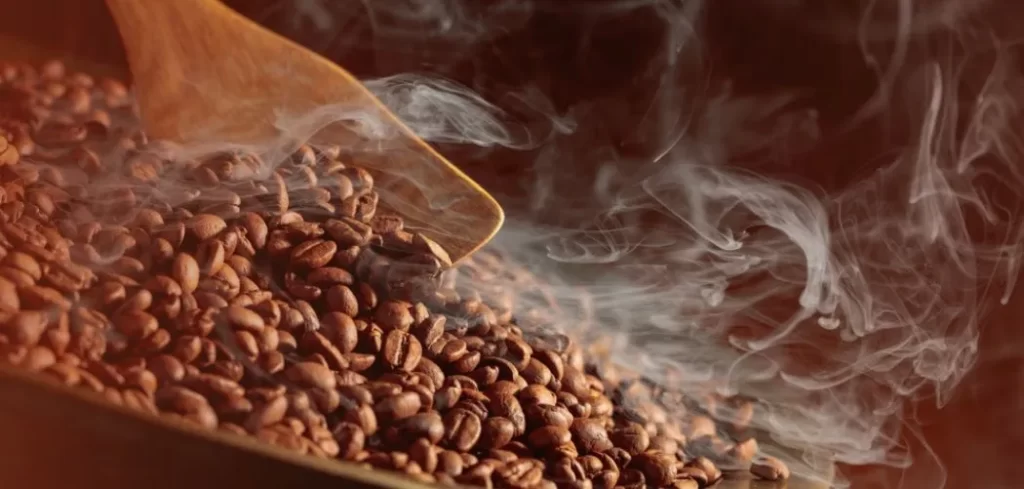Are you tired of mediocre coffee that doesn’t quite hit the spot? Have you ever wondered what it would be like to roast your coffee beans at home? Look no further than pan coffee roasting!
Roasting coffee at home is a rewarding and satisfying experience that allows you to control the flavor and roast level of your coffee. Pan coffee roasting is a simple and affordable way to get started with coffee roasting, and it doesn’t require any fancy equipment or prior experience.
But why roast your coffee at home? For starters, freshly roasted coffee tastes better than store-bought coffee. When coffee is roasted, it undergoes a chemical reaction that creates the unique flavors and aromas we associate with coffee. When coffee is roasted and ground, the volatile compounds that give coffee its flavor and aroma begin to degrade, meaning that fresher coffee is always better.
Roasting coffee at home also allows you to customize the roast level to your liking. Some people prefer a light roast for its bright and acidic flavor, while others prefer a dark roast for its bold and smoky flavor. With pan coffee roasting, you can experiment with different roast levels and find the perfect roast for your taste preferences.
Pan coffee roasting is an easy and rewarding way to roast your coffee beans at home. With a few simple tools and some high-quality beans, you can enjoy fresh, flavorful coffee that’s customized to your liking. In the next section, we’ll cover how to select the right beans for pan coffee roasting.
Selecting the Right Beans
When it comes to coffee roasting, the quality of the beans is just as important as the roasting process itself. Here are some tips for selecting the right beans for pan coffee roasting:
Look for high-quality beans: The quality of the beans you choose will directly impact the quality of your coffee. Look for beans that are freshly roasted, free of defects or blemishes, and sourced from reputable coffee growers.
Consider the origin: Different coffee beans have distinct flavor profiles based on their country of origin. For example, beans from Ethiopia are known for their floral and fruity notes, while beans from Brazil have a nutty and chocolatey flavor.
Decide on roast level: The roast level you choose will also impact the flavor of your coffee. Light roasts have a bright and acidic flavor, while dark roasts have a bold and smoky flavor. Consider the flavor profile you prefer and select beans accordingly.
Experiment with blends: Coffee blends can offer a unique flavor experience by combining beans from different regions. Try experimenting with different blends to find the flavor profile that suits you best.
Look for specialty beans: Specialty coffee beans are beans that have been carefully grown and processed to create unique and complex flavors. Look for specialty beans to take your pan coffee roasting to the next level.
Selecting high-quality beans that are suited to your taste preferences, you can ensure that your pan coffee roasting experience is a success. In the next section, we’ll cover how to prepare your pan for roasting.
Preparing the Pan
Before you start roasting your coffee, you’ll need to prepare your pan. Here are the steps to follow:

Choose the right pan: For pan coffee roasting, you’ll need a heavy-bottomed pan that distributes heat evenly. A cast iron or stainless steel pan is ideal.
Clean the pan: Make sure your pan is clean and free of any residual flavors or odors. You don’t want your coffee to pick up any unwanted flavors!
Preheat the pan: Place the pan on the stove over medium-high heat and allow it to heat up for several minutes. You want the pan to be hot but not smoking.
Add the beans: Once the pan is hot, add your coffee beans to the pan. Make sure to spread them out in a single layer to ensure even roasting.
Stir continuously: As the beans roast, stir them continuously with a wooden spoon or spatula. This will help to ensure that the beans roast evenly and don’t burn.
Watch the color: As the beans roast, they will change color from green to yellow to brown. Keep a close eye on the color of the beans and remove them from the heat once they reach your desired roast level.
Cool the beans: Once the beans are done roasting, remove them from the pan and spread them out on a baking sheet to cool. You can also use a fan or a colander to cool them more quickly.
You can prepare your pan for coffee roasting and ensure that your beans roast evenly and to your desired roast level. In the next section, we’ll cover how to store your freshly roasted coffee.
Roasting the Coffee
Now that you’ve selected your beans and prepared your pan, it’s time to start roasting your coffee. Here’s how to do it:
- Begin roasting: Place your preheated pan with the beans on medium-high heat, and start roasting. As the beans begin to heat up, you’ll notice them starting to crackle and pop.
- Stir the beans: Stir the beans constantly to ensure even roasting. This also prevents the beans from burning.
- Listen for the “first crack”: After a few minutes, you’ll hear the “first crack,” which sounds like popcorn popping. This is an indicator that your beans are light to medium roasted.
- Determine the roast level: Continue roasting for another few minutes until you reach your desired roast level. If you prefer a medium roast, you can stop after the “first crack.” For a dark roast, continue roasting until you hear a “second crack.”
- Watch the color: As the beans roast, you’ll notice them turning darker in color. The final color of the beans should be consistent and uniform.
- Remove the beans from the heat: Once you’ve reached your desired roast level, remove the beans from the heat and transfer them to a cool surface, such as a baking sheet.
- Cool the beans: Allow the beans to cool for several minutes. During this time, they will continue to release carbon dioxide, which is a natural byproduct of the roasting process.
- Store the beans: Once the beans have cooled, store them in an airtight container. This will help to preserve their freshness and flavor.
Roast your coffee to perfection and enjoy a fresh, delicious cup of coffee at home. In the next section, we’ll cover some tips for achieving the perfect brew.
Cooling and Storing the Coffee
Once you’ve finished roasting your coffee, it’s important to cool and store it properly to ensure that it stays fresh and flavorful. Here’s what you need to know:
Cool the coffee: After you’ve finished roasting your coffee, transfer it to a cool surface such as a baking sheet. This will allow it to cool quickly and evenly.
Remove the chaff: Chaff is the outer skin of the coffee bean that comes off during the roasting process. You can remove any remaining chaff by using a colander or mesh strainer.
Store the coffee: Once the coffee has cooled completely, transfer it to an airtight container. This will help to preserve its freshness and flavor. It’s important to store the coffee in a cool, dry place, away from sunlight and moisture.
Wait before brewing: It’s best to wait at least 24 hours before brewing your freshly roasted coffee. This allows the carbon dioxide to escape, which can affect the flavor of the coffee if brewed too soon.
Grind the beans: When you’re ready to brew your coffee, grind the beans just before brewing. This will help to ensure that the coffee is fresh and flavorful.
Freshly roasted coffee stays fresh and flavorful for as long as possible. Enjoy your delicious, homemade coffee! In the next section, we’ll cover some tips for brewing the perfect cup of coffee.
Troubleshooting
Even if you follow all the steps carefully, there may be times when your coffee doesn’t turn out as expected. Here are some common issues that may arise and how to troubleshoot them:

- Uneven roasting: If your coffee beans aren’t roasting evenly, try stirring them more frequently during the roasting process. You can also try using a different pan or adjusting the heat.
- Burnt taste: If your coffee tastes burnt, it’s likely that you left it on the heat for too long. Try reducing the heat or shortening the roasting time.
- Sour taste: If your coffee tastes sour, it may not have roasted for long enough. Try increasing the roasting time slightly.
- Bitter taste: If your coffee tastes bitter, it may have roasted for too long. Try reducing the roasting time or using a lower heat.
- Smoky smell: If your coffee has a smoky smell, it may be because the pan is too hot or the coffee is too close to the heat source. Try adjusting the heat or the placement of the pan.
Remember, roasting coffee is a process that takes practice and patience. Don’t be discouraged if your first few batches don’t turn out perfectly. Keep experimenting and adjusting until you find the perfect roast for your taste preferences. And most importantly, have fun! Roasting your own coffee is a great way to connect with the origins of your favorite drink and to experiment with different flavors and roasting styles.
Conclusion
Roasting your own coffee at home can be a fun and rewarding experience. Not only does it allow you to experiment with different flavors and roasting styles, but it also connects you to the origins of your favorite drink. With the right beans, pan, and technique, you can achieve a perfect roast every time.
Remember to start with high-quality beans and to select the right pan for your stovetop. Preheat the pan and then add the beans, stirring frequently to ensure even roasting. Once the beans are roasted to your desired level, transfer them to a cool surface and allow them to cool completely before storing them in an airtight container.
If you encounter any issues, don’t be discouraged. Troubleshooting is a normal part of the process, and with practice, you’ll be able to perfect your technique.
So why not give pan coffee roasting a try? With a little bit of practice and patience, you can become your own personal coffee roaster and enjoy a delicious cup of coffee that you’ve roasted yourself.
Ronsil
Meet Ronsil, the master barista behind EspressoRivo. With years of experience in the coffee industry, he brings a wealth of knowledge and passion to the table. As the owner of a successful coffee shop, Ronsil is a sought-after adviser in the field. His expertise and love for the craft shines through in every cup he serves. We are honored to have him as part of our team at EspressoRivo






